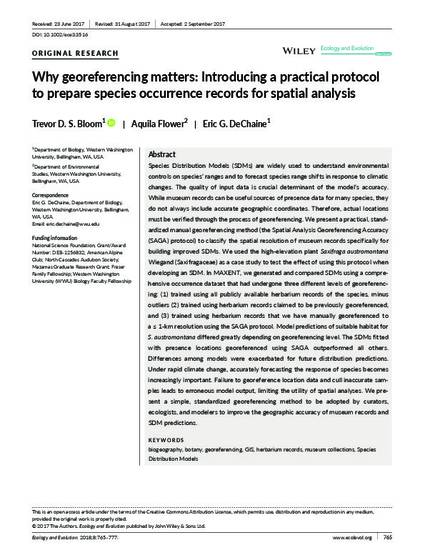
- Biogreography,
- Botany,
- Georeferencing,
- GIS,
- Herbarium records,
- Museum collections,
- Species Distribution Models
Species Distribution Models (SDMs) are widely used to understand environmental controls on species’ ranges and to forecast species range shifts in response to climatic changes. The quality of input data is crucial determinant of the model’s accuracy. While museum records can be useful sources of presence data for many species, they do not always include accurate geographic coordinates. Therefore, actual locations must be verified through the process of georeferencing. We present a practical, standardized manual georeferencing method (the Spatial Analysis Georeferencing Accuracy (SAGA) protocol) to classify the spatial resolution of museum records specifically for building improved SDMs. We used the high-elevation plant Saxifraga austromontana Wiegand (Saxifragaceae) as a case study to test the effect of using this protocol when developing an SDM. In MAXENT, we generated and compared SDMs using a comprehensive occurrence dataset that had undergone three different levels of georeferencing: (1) trained using all publicly available herbarium records of the species, minus outliers (2) trained using herbarium records claimed to be previously georeferenced, and (3) trained using herbarium records that we have manually georeferenced to a ≤ 1-km resolution using the SAGA protocol. Model predictions of suitable habitat for S. austromontana differed greatly depending on georeferencing level. The SDMs fitted with presence locations georeferenced using SAGA outperformed all others. Differences among models were exacerbated for future distribution predictions. Under rapid climate change, accurately forecasting the response of species becomes increasingly important. Failure to georeference location data and cull inaccurate samples leads to erroneous model output, limiting the utility of spatial analyses. We present a simple, standardized georeferencing method to be adopted by curators, ecologists, and modelers to improve the geographic accuracy of museum records and SDM predictions.
Available at: http://works.bepress.com/eric_dechaine/18/
